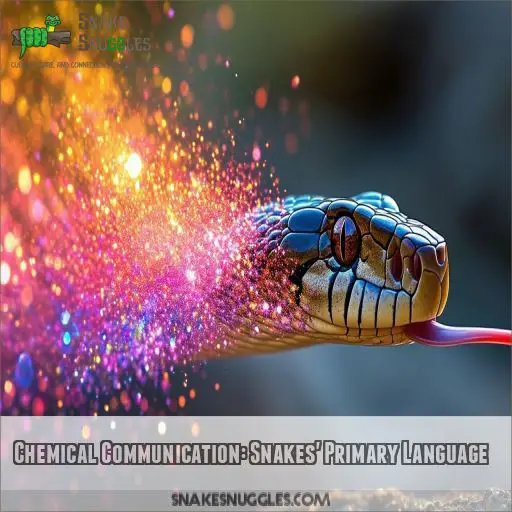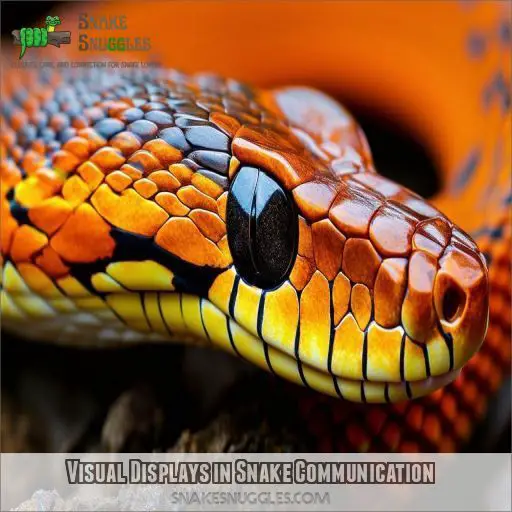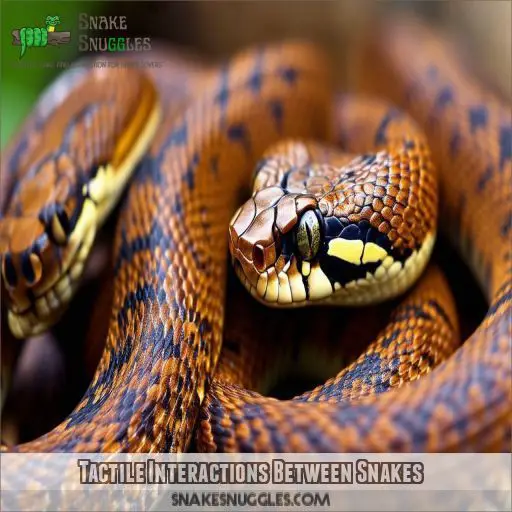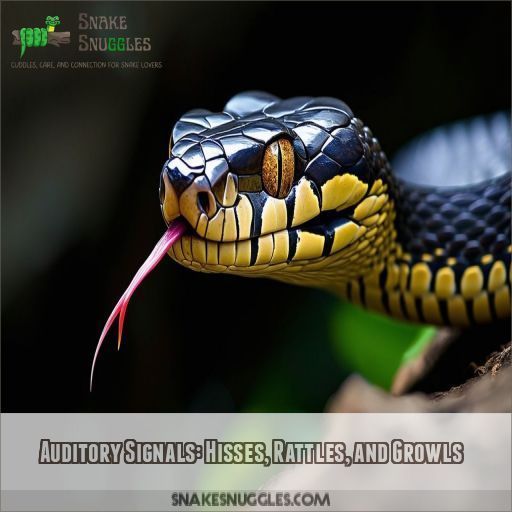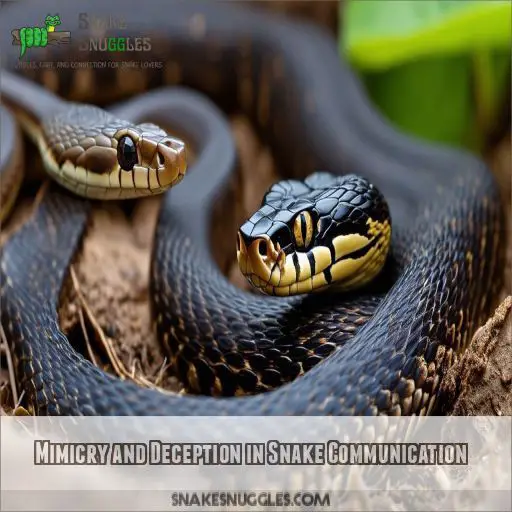This site is supported by our readers. We may earn a commission, at no cost to you, if you purchase through links.

You might be surprised to learn they’re quite the chatterboxes!
Snakes primarily use chemical signals, relying on their forked tongues and a special organ called Jacobson’s organ to "taste" the air.
They leave scent trails that act like snake social media, sharing info about gender, age, and even relationship status.
But that’s not all – snakes are multi-lingual!
They also use visual displays, like the cobra’s famous hood spread, and tactile interactions for everything from courtship to territory disputes.
Some even employ auditory signals, like the rattlesnake’s iconic warning.
Ready to uncover more secrets of serpent communication?
Table Of Contents
- Key Takeaways
- Chemical Communication: Snakes’ Primary Language
- Visual Displays in Snake Communication
- Tactile Interactions Between Snakes
- Auditory Signals: Hisses, Rattles, and Growls
- Mimicry and Deception in Snake Communication
- Frequently Asked Questions (FAQs)
- What type of communication do snakes use?
- Can snakes tell each other apart?
- How do snakes recognize you?
- How do snakes use visual communication?
- Can snakes recognize individual members of their species?
- Do snakes communicate differently underwater versus on land?
- How do blind snake species communicate without visual cues?
- Can snakes from different species understand each others signals?
- Do snakes use body temperature changes to communicate?
- Conclusion
Key Takeaways
- Snakes are chemical chatterboxes, using their forked tongues and Jacobson’s organ to "taste" the air and decode scent trails—it’s like they’re scrolling through a slithery social media feed!
- These scaly Shakespeares are also visual virtuosos, using body language from subtle eye dilations to dramatic hood displays. Who knew snakes were nature’s own emoji artists?
- Don’t be fooled by their reputation as cold-blooded loners—snakes engage in tactile tango, from playful wrestling matches to gentle courtship dances. It’s not all hiss and venom in the serpent world!
- Some snakes are the ultimate con artists, using mimicry to fool predators and potential mates. It’s like nature’s Halloween party, where harmless snakes dress up as their venomous cousins!
Chemical Communication: Snakes’ Primary Language
You might think snakes communicate through hisses and rattles, but their primary language is actually chemical. These slithery creatures use a complex system of pheromones and scent trails to convey messages about everything from mating readiness to territorial boundaries, all thanks to their remarkable vomeronasal system.
Vomeronasal System and Jacobson’s Organ
Ever wondered how snakes "smell" their world? Meet the Jacobson’s organ, a snake’s secret weapon! This nifty system lets them taste the air, picking up chemical cues like a super-sensitive nose. It’s their key to survival!
Pheromone Production and Detection
You might be surprised to learn that snakes are expert chemists! They produce and detect pheromones, their secret language. Here’s how they do it:
- Skin glands secrete chemical signals
- Tongue flicks collect airborne molecules
- Jacobson’s organ decodes the message
Chemical Trails for Navigation and Mating
You’d be amazed at how snakes leave chemical breadcrumbs! These slithery creatures use pheromone trails for navigation and mating. Let’s peek at their secret world:
| Trail Type | Purpose | Duration |
|---|---|---|
| Mating | Find mates | Short-term |
| Navigation | Locate dens | Long-lasting |
| Territorial | Mark boundaries | Varies |
Role of Tongue Flicking in Chemical Sensing
You’ve seen snakes flick their tongues, right? It’s not just for show! This quirky behavior is their secret weapon for chemical sensing. Here’s how it works:
- Tongue collects scent particles
- Particles transferred to Jacobson’s organ
- Organ analyzes chemical information
- Brain processes sensory input
Species-specific Chemical Signals
You’d be amazed at how snakes speak their own chemical dialects! Each species has its unique scent signature, like a fragrant fingerprint. These pheromone passwords help snakes find mates, mark territory, and even send "Keep Out" signs to rivals.
Visual Displays in Snake Communication
While snakes are masters of chemical communication, they’re also visual virtuosos.
You’d be surprised at how these slithery creatures use their bodies as living billboards!
From the cobra’s iconic hood spread to the vibrant warning colors of coral snakes, visual displays are a key part of snake language.
These silent signals can scream "Back off!" louder than any hiss.
Ever seen a snake puff up its body? That’s its way of saying, "I’m bigger than you think!"
Even subtle changes in posture or eye dilation can speak volumes in snake-speak.
It’s like they’re nature’s own emoji artists!
Tactile Interactions Between Snakes
You might think snakes are all about hisses and venom, but they’ve got a softer side too. These slithery creatures use touch to communicate, engaging in everything from playful wrestling matches to gentle courtship dances.
Combat Rituals for Dominance
You’ve seen snakes coil and strike, but did you know they wrestle? Snake combat isn’t just for show. These rituals establish dominance and hierarchy. Males intertwine, pushing and shoving, trying to pin each other down. It’s nature’s version of arm wrestling!
Mating Behaviors and Courtship
You might think snakes are cold-blooded in love, but their courtship is a delicate dance. During mating season, male snakes use tactile cues to woo their potential mates. Here’s how they turn up the heat:
- Gentle body rubs
- Head bobbing
- Tail twitches
- Rhythmic tongue flicks
Tactile Cues for Territory Marking
You’ve seen how snakes court, but did you know they’re also territorial? These slithery creatures use touch to mark their turf. Let’s explore how snakes leave their "signature" on their surroundings:
| Method | Purpose | Species Example |
|---|---|---|
| Rubbing | Scent marking | Garter snakes |
| Trailing | Territory boundaries | Pythons |
| Cloacal dragging | Pheromone deposition | King cobras |
| Body pressing | Scent transfer | Rat snakes |
Physical Contact in Social Groupings
You’ll be surprised to learn that snakes aren’t always loners. They use physical contact to communicate in social groups. Here’s what you need to know:
- Body language speaks volumes
- Social cues through touch
- Tail wagging isn’t just for dogs
- Scent marking creates group dynamics
Auditory Signals: Hisses, Rattles, and Growls
You might think snakes are silent creatures, but they’ve got a few auditory tricks up their scales. From the menacing hiss of a threatened python to the iconic rattle of a rattlesnake’s tail, these reptiles use sound to communicate in ways that’ll make your ears perk up.
Hissing as a Warning Mechanism
While snakes aren’t big talkers, they’ve got a powerful vocal trick up their scaly sleeves: hissing. This isn’t just a spooky sound effect; it’s a key part of their defense strategy. Let’s break down the hiss:
| Hiss Type | Purpose | Sound Level | Typical Scenario |
|---|---|---|---|
| Soft Hiss | Mild warning | Low | Startled by movement |
| Sharp Hiss | Immediate threat | Medium | Cornered or touched |
| Sustained Hiss | Serious danger | High | Predator nearby |
| Puff Hiss | Intimidation | Varied | Defending territory |
Rattlesnake Communication Through Tail Vibrations
While hissing is common, rattlesnakes take it up a notch with their iconic tail vibrations. This unique defense mechanism serves as a clear "back off" signal to potential threats. Here’s what you need to know about this fascinating form of snake communication:
- Rapid muscle contractions create the distinct rattling sound
- The rattle is made of interlocking segments of keratin
- Vibrations can reach up to 50 cycles per second
- Baby rattlesnakes are born with a single button, adding segments as they grow
- The sound can be heard from up to 20 feet away
Low-frequency Growls in King Cobras
While rattlesnakes shake things up, king cobras have a different trick up their scales. They emit low-frequency growls that’ll send chills down your spine. These regal serpents might be using their growls for more than just scaring you off—it’s their secret social language!
Auditory Perception in Snakes
While king cobras growl, you might wonder about snakes’ hearing. Surprise! They’re not deaf, but their auditory perception is limited. Snakes can detect low-frequency sounds and ground vibrations. It’s like they’re tuned into nature’s bass-heavy playlist, feeling the beat through their bodies.
Mimicry and Deception in Snake Communication
You might think snakes are straightforward creatures, but they’ve got a few tricks up their scaly sleeves when it comes to communication. Some snakes are masters of deception, using mimicry to fool predators and potential mates alike, proving that in the serpent world, appearances can be deceiving.
Visual Mimicry of Venomous Species
You’ve heard of snakes’ hisses, but did you know some are master impersonators? It’s like nature’s Halloween costume party! Some harmless snakes have evolved to look like their venomous cousins. This clever trick, called Batesian mimicry, helps them survive by fooling predators.
Chemical Mimicry for Predator Avoidance
Did you know snakes can pull off chemical disguises? It’s like nature’s ultimate magic trick! Your Jacobson’s organ would be fooled by these sneaky serpents. Here’s how they do it:
- Mimic predator scents
- Copy toxic prey chemicals
- Mask their own odor
- Confuse vomeronasal systems
Mimicry in Mating Strategies
Snakes are masters of deception, even in love! Some male snakes use mimicry to trick rivals during mating season. They’ll emit female-like pheromones, confusing other males and gaining an edge in the race for reproduction. Talk about sneaky serpents!
Evolutionary Advantages of Deceptive Communication
You’ve seen how snakes use deception, but why? It’s all about survival. Evolution’s given these slippery characters a leg up (pun intended!) through mimicry. By fooling predators and prey alike, snakes increase their chances of living to slither another day.
Frequently Asked Questions (FAQs)
What type of communication do snakes use?
You might think snakes are silent, but they’re chatty in their own way! They use chemical signals, body language, and even sounds. Snakes communicate through pheromones, physical displays, and some species hiss or rattle to convey messages.
Can snakes tell each other apart?
You bet snakes can tell each other apart! They’re not just slithering strangers. Using their keen sense of smell, they pick up on unique chemical signatures, like a scaly version of recognizing your friend’s perfume.
How do snakes recognize you?
You’re not just a blur to snakes! They’ll recognize you through scent and movement patterns. Your unique chemical signature and behavior become familiar over time. It’s like they’re saying, "Hey, I know that human!
How do snakes use visual communication?
You’ll notice snakes use visual cues to communicate. They’ll coil up, flare their necks, or wave their tails. It’s like their own silent language! Watch closely, and you’ll see them "talking" without saying a word.
Can snakes recognize individual members of their species?
Picture a snake recognizing its neighbor – it’s not so far-fetched! You’d be surprised, but snakes can indeed distinguish individual members of their species. They use chemical cues and pheromones to identify specific snakes, much like a scaly fingerprint system.
Do snakes communicate differently underwater versus on land?
You’ll find snakes adapt their communication underwater. They rely more on chemical signals and tactile cues, as sound doesn’t travel well. On land, they’ve got a full arsenal: visual displays, scent trails, and even those famous rattles!
How do blind snake species communicate without visual cues?
You’d be surprised how blind snakes manage without sight! They rely heavily on chemical cues, using their forked tongues to "taste" the air. They also communicate through touch and vibrations, feeling their way through their world.
Can snakes from different species understand each others signals?
When you dive into how snakes communicate, you’ll find they can often understand each other’s signals. They’re fluent in chemical cues, body language, and some common behaviors, allowing for basic interactions across species lines. It’s a hiss-tory of adaptation!
Do snakes use body temperature changes to communicate?
While snakes don’t actively change their body temperature to communicate, they can detect heat from other snakes. You’ll find this ability helps them locate potential mates or prey, rather than serving as a direct communication method.
Conclusion
You might think snakes are silent creatures, but they’re actually master communicators!
From chemical trails to visual displays, tactile interactions, and even auditory signals, snakes have a rich language all their own.
Understanding how snakes communicate isn’t just fascinating—it’s key for conservation efforts and human safety.
So next time you encounter a snake, remember: they’re not just slithering around aimlessly.
They’re sharing stories, finding mates, and getting around their world through a complex network of sensory signals.
In more ways than you’d ever imagine!

